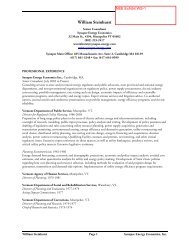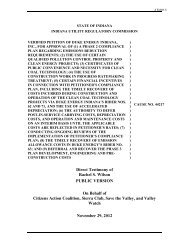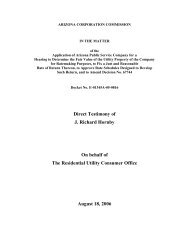Best Practices in Energy Efficiency Program Screening - Synapse ...
Best Practices in Energy Efficiency Program Screening - Synapse ...
Best Practices in Energy Efficiency Program Screening - Synapse ...
Create successful ePaper yourself
Turn your PDF publications into a flip-book with our unique Google optimized e-Paper software.
educe a program’s overall cost-effectiveness, the program adm<strong>in</strong>istrator may be able to<br />
achieve greater overall sav<strong>in</strong>gs through the comb<strong>in</strong>ation of measures. Additionally, a<br />
measure may not be cost-effective on its own, but may become cost-effective when<br />
comb<strong>in</strong>ed with other efforts. 32 (NAPEE 2008, pp.3-9, 3-10).<br />
Evaluat<strong>in</strong>g cost-effectiveness at the portfolio level means that all of the programs taken<br />
together must be cost-effective, but <strong>in</strong>dividual programs can be positive or negative.<br />
This is the most flexible application of cost-effectiveness test<strong>in</strong>g, as program<br />
adm<strong>in</strong>istrators have the ability to experiment with different strategies and technologies<br />
that may not be immediately cost-effective or require further test<strong>in</strong>g, such as pilot<br />
programs, market transformation programs, or emerg<strong>in</strong>g technologies. (NAPEE 2008,<br />
pp. 3-9, 3-10).<br />
A recent ACEEE report surveyed states on the level at which program adm<strong>in</strong>istrators<br />
screen for cost-effectiveness. The most prevalent responses to the question of “what<br />
level” the benefit-cost tests are applied were: the “portfolio” level (30 states, 70%) and<br />
the “program” level (30 states, 70%), although nearly half of those states noted that they<br />
had some expectations at the program level (e.g., low-<strong>in</strong>come programs, pilot programs,<br />
etc.) where the benefit-cost test was not required or waivers were granted. Thirteen<br />
states (30%) applied their benefit-cost test requirements at the measure level, and a<br />
majority of those states provide exceptions for th<strong>in</strong>gs like low-<strong>in</strong>come programs and/or<br />
situations where measures can be bundled together <strong>in</strong>to a cost-effective package of<br />
measures (e.g., certa<strong>in</strong> “whole house” type programs). (ACEEE 2012, p.31).<br />
F<strong>in</strong>ally, it is important to note that <strong>in</strong> addition to screen<strong>in</strong>g energy efficiency programs for<br />
plann<strong>in</strong>g purposes, it is also possible to screen energy efficiency programs at the po<strong>in</strong>t<br />
of implementation, i.e., “field screen<strong>in</strong>g.” Field screen<strong>in</strong>g can be applied dur<strong>in</strong>g the<br />
process of audit<strong>in</strong>g homes and bus<strong>in</strong>esses for retrofits, and may be important to provide<br />
customers with assurance that certa<strong>in</strong> efficiency measures will be appropriate to the<br />
unique conditions of their build<strong>in</strong>g. The best test to use <strong>in</strong> field screen<strong>in</strong>g is the<br />
Participant Cost test, because this test <strong>in</strong>dicates which efficiency measures the customer<br />
should adopt and what the customer benefits of those measures will be.<br />
The TRC test should not be used for field screen<strong>in</strong>g energy efficiency measures, for<br />
several reasons. First, it is especially difficult to properly account for other program<br />
impacts at the measure level for each build<strong>in</strong>g; and without the OPIs the TRC test will be<br />
skewed aga<strong>in</strong>st the energy efficiency measures. Second, measure level field screen<strong>in</strong>g<br />
does not account for the <strong>in</strong>teractions between measures, particularly the benefits that<br />
one measure might have <strong>in</strong> encourag<strong>in</strong>g customers to adopt other measures. Third,<br />
experience has demonstrated that measure-level field screen<strong>in</strong>g is overly restrictive, can<br />
exclude measures that are cost-effective to customers, <strong>in</strong>creases the transaction costs<br />
of contractors and customers, creates lost opportunities, and h<strong>in</strong>ders the goal of<br />
achiev<strong>in</strong>g comprehensive, whole-house efficiency sav<strong>in</strong>gs.<br />
32 Summ<strong>in</strong>g up the benefits of multiple measures at the program level may require some adjustment for<br />
what are known as “<strong>in</strong>teractive effects” between related measures. Interactive effects occur when<br />
multiple measures <strong>in</strong>stalled together affect each other’s impacts. When measures affect the same end<br />
use, their comb<strong>in</strong>ed effect when implemented together may be less than (or more than) the sum of each<br />
measure’s <strong>in</strong>dividually estimated impact. (ACEEE 2008, p.3-10).<br />
| 56 <strong>Best</strong> <strong>Practices</strong> <strong>in</strong> <strong>Energy</strong> <strong>Efficiency</strong> <strong>Program</strong> Screen<strong>in</strong>g | www.nhpci.org







